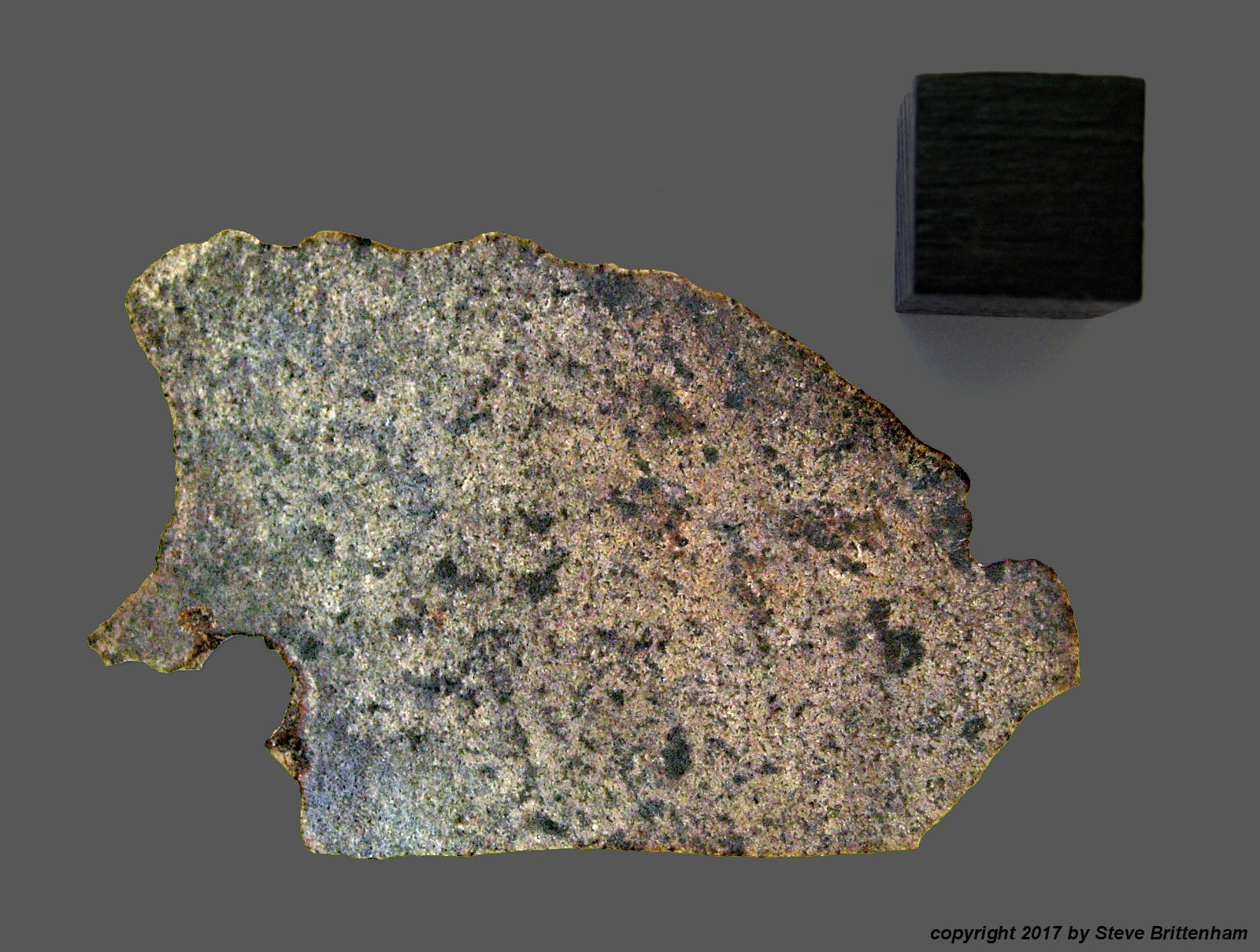|
Roll Overs:
#1
#2
|

|
|
Copyright (c) Steve Brittenham.
|
3.67 grams. Martian (shergottite)
TKW 1056 grams. Fall not observed. Found 24 January 2000 in Oman.
  
Steve writes:
The 1056 gram Dhofar 019 meteorite was found in the desert of Oman on
January 24, 2000. Highly weathered and lacking any fusion crust, its
texture, mineralogy, major element chemistry, and trace elements resulted in
its classification as the 17th Martian meteorite. Dhofar 019 is a
shergottite (an igneous rock of plutonic or volcanic origin that resembles
its terrestrial cousins more than they do other achondrite meteorites).
Less than half a percent of known meteorites come from Mars, but of those,
the shergottites are the most common of the SNCs and are further subdivided
into three distinct subgroups - basaltic, lherzolitic, and olivine-phyric
(Dhofar 109 is an olivine bearing doleritic basalt). Alternatively,
shergottites can be categorized into as many as four unique groups based on
their rare-earth element content, but these two classification systems do
not align with each other, suggesting complex relationships between the
various source rocks and magmas that the shergottites formed from.
When I first acquired Dhofar 019 several years ago, it was rather unique:
not only was its bulk chemistry similar to India's 1865 Shergotty meteorite
- the type specimen for shergotittes - but it's crystallization age of more
than 550 million years was, like its famous cousin ALH84001, quite different
than the 150 to 250 million year ages of the majority of Martian meteorites
known at that time1. Like EETA79001A and DaG 476/489, Dhofar 019 was
unusual in its lack of orthopyroxenes. And while alteration from
terrestrial weathering was assumed to explain the older carbonate radiogenic
dating results in the younger shergottites, Raman spectroscopic analysis
suggested Martian alteration in Dhofar 019's (as did testing of ALH84001 -
whose unusual carbonate globules are similar to Dhofar 019's
smectite-calcium-gypsum "orangettes").
However, more recent analyses of subsequent Martian meteorites suggest two
Martian reservoirs - one far less radiogenic than the other - mixed, causing
ambiguous trends in Pb isotope variation that result in inaccurate estimates
of Martian meteorites' ages. In addition, distinctly different oxygen
reservoirs, because of the lack of plate tectonics, continue to exist, thus
providing a highly bimodal pattern of surface ages on Mars and allowing for
a broader range of origins in the plains of the northern hemisphere (though
such exceptions as the 4.4 billion year "Black Beauty" and ALH84001 still
likely came from the more ancient southern upland regions). These new
findings also allow for a Martian origin for the previously assumed
terrestrially weathered carbonates found in a large number of Martian
meteorites.
While Dhofar 019 was no longer necessarily unique in its indications of
Martian weathering or having one of the oldest crystallization ages of any
Martian meteorite, it was still unusual in exhibiting excessive cosmic ray
exposure and having a heterogeneous interior with apparent layering that
gives it a texture visually quite different from coarse-grained shergottites
like Zagami. This 3.67 gram slice of Dhofar 019 also exhibits a distinctive
red/green bicolor appearance that makes it one of the favorite Martian
meteorites in my collection.
Footnote
1 With the notable exception of a very few unique examples like Dhofar 019
and ALH 84001, the majority of the first twenty or so Martian meteorites
shared similar bulk chemistries and extremely young crystallization ages -
ages younger than most of the Martian surface. At the time, these
observations suggested a most unlikely explanation: most Martian meteorites
came from an area that covered only a few percent of the total surface on
Mars. The prevailing explanation for this 1990's "Martian age paradox"
suggested the bulk of the shergottites were ejected in a single event from
the northern plains of Mars rather than in multiple events, with the few
more ancient exceptions coming from separate events in the much older
southern uplands. Even as late as the mid 2000's, scientists were
suggesting new reasons to support a limited source area for most Martian
meteorites.
|
Click to view larger photos
#1
#2
|
Found at the arrow (green or red) on the map below
|
|
| |
Steve Brittenham
6/18/2017 2:52:29 PM |
You know, John, that's a very good question. I never thought about it, nor have I looked that closely at it under a zoom microscope. It's packed deep down inside a box locked in my the safe right now - otherwise I'd pull it out and look at it. Definitely has me curious . . . |
John Divelbiss
6/18/2017 12:09:33 PM |
Is that the outline of a vesicle/vug on the left side of Pic 1 ? Nice writeup on the martian rocks, and I agree that Dhofar 019 is a unique looking achondrite. my *1 gram slice also has a reddish hue to it. |
| |
|